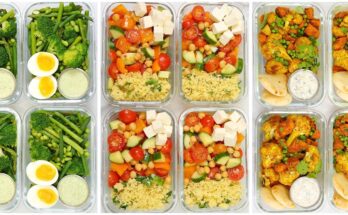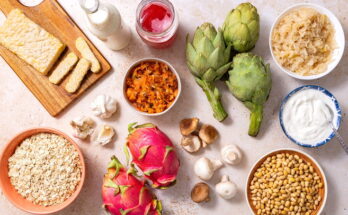Pierogi Recipe: Pierogi are delightful dumplings with Eastern European roots, loved for their versatility and comforting flavors. These pockets of dough are typically filled with savory or sweet ingredients like mashed potatoes, cheese, meats, or fruits.
Whether served as a main course or a dessert, pierogi are a staple in Polish cuisine and have won hearts worldwide. Making pierogi from scratch may seem daunting, but with this step-by-step guide, you’ll master the art in no time.
Ingredients for Pierogi
For the Dough:
- All-purpose flour: 3 cups
- Egg: 1 large
- Water: ¾ cup (lukewarm)
- Salt: ½ teaspoon
- Butter or oil: 2 tablespoons (optional, for added softness)
For the Fillings:
- Potato and Cheese Filling: Mashed potatoes (2 cups), shredded cheddar cheese (1 cup), salt, and pepper to taste.
- Meat Filling: Ground beef or pork (1 lb), finely chopped onion (1 small), salt, pepper, and garlic powder to taste.
- Sweet Filling: Fresh or dried fruits, sugar, and a pinch of cinnamon.
Optional Additions:
- Fresh herbs like dill or parsley.
- Caramelized onions for garnish.
Essential Kitchen Tools
To streamline the pierogi-making process, gather the following tools:
- Rolling pin
- Large mixing bowls
- A round cutter or glass (3-inch diameter)
- A large pot for boiling
- Slotted spoon
- Skillet (for frying, optional)
For beginners, silicone mats and dough scrapers can be particularly handy, ensuring an easy cleanup and precise dough handling.
Preparing the Dough
Making the dough is the foundation of perfect pierogi. Follow these steps:
- Mix Ingredients: In a large bowl, combine flour and salt. Add the egg and mix until crumbly.
- Add Water Gradually: Pour lukewarm water in small increments while kneading. This ensures the dough stays soft but not sticky.
- Knead: Knead the dough on a floured surface for 8-10 minutes until smooth and elastic.
- Rest the Dough: Cover with a clean kitchen towel or plastic wrap and let it rest for 30 minutes. This helps relax the gluten for easier rolling.
Pro Tip: Avoid over-kneading, as this can make the dough tough.
Making the Filling
While the dough rests, prepare your desired filling:
Potato and Cheese Filling:
- Boil peeled potatoes until tender. Mash them with cheese, salt, and pepper.
- Ensure the mixture is smooth and not too wet, as excess moisture can weaken the dough.
Meat Filling:
- Cook ground meat with finely chopped onions. Season with salt, pepper, and garlic powder.
- Allow the mixture to cool before filling the pierogi.
Sweet Filling:
- Combine chopped fruits with sugar and a pinch of cinnamon. For dried fruits, rehydrate them in warm water before mixing.
Store fillings in the fridge if you’re not using them immediately.
Assembling the Pierogi
This is where the magic happens. Follow these steps for flawless pierogi:
- Roll Out the Dough: On a floured surface, roll out the dough to about 1/8-inch thickness.
- Cut Circles: Use a round cutter or the rim of a glass to cut dough circles.
- Add Filling: Place a teaspoon of filling in the center of each circle. Avoid overfilling to prevent leaks.
- Seal the Edges: Fold the dough over the filling to create a half-moon shape. Press the edges firmly together and crimp with a fork for extra security.
Pro Tip: Keep unused dough covered to prevent drying out.
Cooking the Pierogi
Pierogi can be boiled, pan-fried, or both, depending on your preference.
Boiling Method:
- Bring a large pot of salted water to a rolling boil.
- Drop pierogi in batches, ensuring they don’t overcrowd.
- Cook for 3-5 minutes or until they float to the surface.
Pan-Frying Method (Optional):
- Heat butter or oil in a skillet over medium heat.
- Fry the boiled pierogi until golden and crispy on each side.
Pro Tip: Serve immediately for the best texture and flavor.
Serving Suggestions
Once your pierogi are cooked to perfection, it’s time to plate them up! Traditional accompaniments and creative garnishes elevate the experience.
Classic Toppings:
- Sour cream: A rich, tangy addition that complements both savory and sweet pierogi.
- Caramelized onions: Slowly sautéed onions in butter add a touch of sweetness and depth.
- Fresh herbs: Sprinkle dill, parsley, or chives for a fresh, aromatic twist.
Creative Twists:
- Crispy bacon bits: Adds a salty, smoky crunch to savory pierogi.
- Sweet drizzle: For dessert pierogi, try honey, chocolate sauce, or powdered sugar.
Perfect Pairings:
- Serve with a side of cabbage rolls or sauerkraut for a full Eastern European feast.
- Pair with borscht (beet soup) for a warm, comforting meal.
Pierogi Variations
Pierogi recipes vary widely across regions and personal preferences. Here are some exciting variations to try:
Savory Options:
- Sauerkraut Pierogi: Tangy sauerkraut filling mixed with onions and mushrooms.
- Spinach and Feta: A Mediterranean twist with spinach, feta cheese, and a hint of nutmeg.
Sweet Delights:
- Blueberry Pierogi: Juicy blueberries with a touch of sugar and lemon zest.
- Chocolate and Banana: A decadent dessert option perfect for kids and adults alike.
Modern Flavors:
- Buffalo Chicken Pierogi: Spicy chicken filling with cream cheese and hot sauce.
- Taco Pierogi: Ground beef, cheddar cheese, and taco seasoning, served with salsa and guacamole.
Pro Tip: Don’t hesitate to experiment with flavors; the pierogi dough is a blank canvas for your creativity!
Tips for Storing and Freezing
Pierogi are ideal for batch cooking, and they store well for future meals. Here’s how to keep them fresh:
Storing Cooked Pierogi:
- Store in an airtight container in the fridge for up to 3 days.
- Reheat by boiling briefly or pan-frying.
Freezing Uncooked Pierogi:
- Place uncooked pierogi in a single layer on a baking sheet lined with parchment paper.
- Freeze until solid, then transfer to a freezer-safe bag or container.
- Cook directly from frozen; no need to thaw.
Reheating Tips:
- For crispy pierogi, pan-fry directly from the fridge or freezer.
- Avoid microwaving as it may make the dough soggy.
Troubleshooting Common Issues
Even seasoned cooks can encounter challenges when making pierogi. Here’s how to address them:
Dough Too Sticky or Dry:
- If sticky, add a small amount of flour while kneading.
- If dry, incorporate a teaspoon of water at a time until smooth.
Fillings Leaking Out:
- Ensure edges are tightly sealed, using water or egg wash if needed.
- Avoid overfilling.
Pierogi Sticking Together:
- Dust the dough and filled pierogi with flour before cooking or freezing.
- Stir gently while boiling to prevent clumping.
Nutritional Information
Pierogi are hearty and delicious, but understanding their nutritional content can help you enjoy them mindfully.
Caloric Breakdown:
- A single pierogi (savory) typically contains 70-90 calories, depending on the filling and preparation method.
- Sweet pierogi may range from 100-120 calories each.
Healthier Substitutions:
- Use whole wheat flour or gluten-free alternatives for the dough.
- Opt for low-fat cheese or plant-based fillings.
Special Diet Options:
- Vegan pierogi: Replace the egg in the dough with a flaxseed or chia seed mixture, and use plant-based fillings.
- Gluten-free pierogi: Substitute with gluten-free flour blends.
FAQs about Pierogi Recipe
What are pierogis?
Pierogis are traditional Polish dumplings made from dough that’s typically filled with a variety of ingredients such as mashed potatoes, cheese, meat, or even fruits, and then boiled or fried.
How do you make pierogis from scratch?
To make pierogis from scratch, start by preparing the dough with flour, water, egg, and salt. Mix until it forms a smooth, elastic consistency. For the filling, you can use mashed potatoes mixed with cheese or cooked onions. Roll out the dough, cut it into circles, place a spoonful of filling in the center, and fold the dough over, sealing the edges. Cook the pierogis by boiling them until they float to the top, then fry in butter if desired.
Can you freeze pierogis?
Yes, pierogis freeze very well. It’s best to freeze them before cooking. Place them on a baking sheet in a single layer until solid, then transfer to a freezer-safe bag or container. They can be boiled or fried directly from the freezer when ready to eat.
What are the best toppings for pierogis?
Common toppings for pierogis include sour cream, fried onions, bacon bits, and fresh herbs like parsley or dill. For a sweeter version, you can top fruit-filled pierogis with powdered sugar or a dollop of whipped cream.
Are pierogis healthy?
Pierogis can be part of a balanced diet but tend to be carb-heavy due to the dough and potato-based fillings. Using whole wheat flour for the dough and incorporating vegetables or lean proteins in the fillings can make them healthier.
Conclusion
Homemade pierogi are more than just a meal; they’re a labor of love that brings people together. From rolling the dough to perfecting the fillings, each step is worth the effort when you take that first bite of your creation. Don’t be afraid to experiment with flavors and techniques—your personalized pierogi masterpiece awaits!
Enjoy the satisfaction of making this classic dish from scratch, and share it with family and friends for a truly special experience. Happy cooking!



